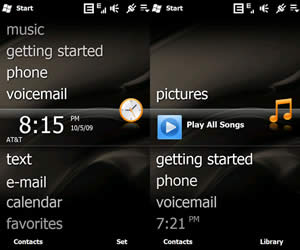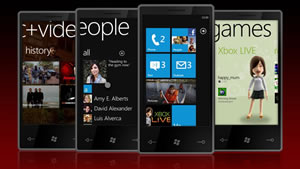Difference between Windows Mobile 6.5 and Windows Phone 7
Key Difference: Windows Mobile 6.5 was introduced initially as a stopgap update to the Windows Mobile 6.1 operating system. This update was intended to reduce the gap between the 6.1 OS and the 7 OS, making it easier to shift from the older system to the newer one. Windows Phone 7 is not exactly an upgrade of Windows Mobile 6.5; it is a completely revamped and new operating system. Windows Phone 7 is built on a different kernel from the Windows Mobile and is not backward compatible. Windows Phone 7 was quite a step up from the Windows Mobile 6.5 operating system. In addition to changing the looks of the OS, the company also added and removed many features from the older version.
 Microsoft and Windows have become a household name with many people owning something by the company: a phone, laptop, desktop, etc. The company was one of the first few companies to foray into the smart devices market, with the launch of Palm Pilots or Palm PCs. These devices were aimed at businessmen for organizing appointments, contacts and other information. Smartphones are basically a blend of a cell phone and a PDA, hence Windows is considered to have a big hand in the popularity of smartphones. The company offered various popular Windows operating systems for mobile which were known as Windows Mobile; these were later renamed to Windows Phone when the company decided to go with a whole new look and design. Windows Mobile 6.5.5 was the last version of the Windows Mobile operating systems, before the company introduced its brand new Windows Phone operating systems.
Microsoft and Windows have become a household name with many people owning something by the company: a phone, laptop, desktop, etc. The company was one of the first few companies to foray into the smart devices market, with the launch of Palm Pilots or Palm PCs. These devices were aimed at businessmen for organizing appointments, contacts and other information. Smartphones are basically a blend of a cell phone and a PDA, hence Windows is considered to have a big hand in the popularity of smartphones. The company offered various popular Windows operating systems for mobile which were known as Windows Mobile; these were later renamed to Windows Phone when the company decided to go with a whole new look and design. Windows Mobile 6.5.5 was the last version of the Windows Mobile operating systems, before the company introduced its brand new Windows Phone operating systems.
Windows Mobile 6.5 was introduced initially as a stopgap update to the Windows Mobile 6.1 operating system. This update was intended to reduce the gap between the 6.1 OS and the 7 OS, making it easier to shift from the older system to the newer one. The update was never part of Microsoft’s plan and was considered as a minor update to the older system until the company launched the new Windows Phone 7 OS in 2010. The update was announced at the 2009 Mobile World Congress and the first phones running this system were launched in October 2009. The company also provided three minor updates for the system, 6.5.1, 6.5.3 and 6.5.5, which were made to help customers transition from the Windows Mobile to the new Windows Phone. The 6.5 operating system came with an updated user interface that was similar to the one offered on Microsoft’s Zune player. The UI offered a new Today screen and vertically scrollable labels named “Titanium”. The company also provided a new Internet Explorer 6 browser. In addition to the new OS, the company also announced several new cloud computing services such as: SkyBox, SkyLine, SkyMarket. The SkyMarket was similar to the Android Market and offered downloadable apps for users.
 Windows Phone 7 is not exactly an upgrade of Windows Mobile 6.5; it is a completely revamped and new operating system. The company chose to change its look and offerings in an attempt to make the system popular again with the Windows customers. Windows Phone 7 is built on a different kernel from the Windows Mobile and is not backward compatible, meaning that apps that work on the 7 will not work on the older versions and vice-versa. The operating system was announced at the 2010 Mobile World Congress and was released worldwide on October 21, 2010. The operating system was completely different in terms of aesthetics and offered a whole new UI, named Metro. This update was also the first time the company showed off its Windows Live Tiles that are directly linked to applications and provides updates directly on the Start screen. It also allowed users to input text via an on-screen virtual keyboard. The 7.5 update introduced thread system messaging, People hub, New IE 9 web browser, and support for Hotmail, Exchange, Yahoo! Mail and Gmail. Windows Phone 7 also offered a new multimedia platform (Music + Videos hub), Games hub, search engine, Microsoft Office Mobile, multitasking capabilities and sync capabilities.
Windows Phone 7 is not exactly an upgrade of Windows Mobile 6.5; it is a completely revamped and new operating system. The company chose to change its look and offerings in an attempt to make the system popular again with the Windows customers. Windows Phone 7 is built on a different kernel from the Windows Mobile and is not backward compatible, meaning that apps that work on the 7 will not work on the older versions and vice-versa. The operating system was announced at the 2010 Mobile World Congress and was released worldwide on October 21, 2010. The operating system was completely different in terms of aesthetics and offered a whole new UI, named Metro. This update was also the first time the company showed off its Windows Live Tiles that are directly linked to applications and provides updates directly on the Start screen. It also allowed users to input text via an on-screen virtual keyboard. The 7.5 update introduced thread system messaging, People hub, New IE 9 web browser, and support for Hotmail, Exchange, Yahoo! Mail and Gmail. Windows Phone 7 also offered a new multimedia platform (Music + Videos hub), Games hub, search engine, Microsoft Office Mobile, multitasking capabilities and sync capabilities.
Windows Phone 7 was quite a step up from the Windows Mobile 6.5 operating system. In addition to changing the looks of the OS, the company also added and removed many features from the older version. Windows Mobile 6.5 was highly customizable, with many companies incorporating their own UIs on the OS and completely changing the look of the OS. This was eliminated in the Windows Phone 7, with the company demanding a set of requirements from the manufacturers. GSMArena states these requirements as: WVGA Capacitive Screen Size, capable of at least four touch points, 1Ghz processor with GPU Acceleration, 256MB of RAM, 8 GB of Flash Storage, 5 MP camera with LED Flash, A-GPS, Compass, Accelerometer, Ambient Light, Proximity Sensor and Three hardware keys: Start, Search and Back.
The company also did not allow any direct changes to the OS, requiring that the Live Tiles stay visible on the Start screen. The applications and other software in Windows Mobile 6.5 were organized in Tabs, while in Windows Phone 7 they are shown in Live Tiles. Windows Mobile 6.5 required users to click on the Menu button to see all the available applications on the device, while on Windows Phone 7 swiping to the right on the Start screen allows users to see all the applications in an alphabetical list. In Windows Mobile 6.5, the application tabs can be shifted around on the Menu screen, allowing users to place the apps according to use. However, in Windows Phone 7 users can pin the applications to the Live tiles. Windows Mobile 6.5 also offers multitask capability, allowing users to download a Task Manager that users can use for app switching. In Windows Phone 7, this wasn’t available until a later update allowed users to hold down the back button which showed a screenshot of the last five access apps. Another major difference is that Windows Mobile App Store, the App store in Windows Phone 7 is more neatly organized and offers many more apps compared to the one in Windows Mobile 6.5. One glitch that was a recurring problem in Windows Mobile 6.5 was that the phone and the apps would hang and not load, requiring the user to soft reset the phone constantly. This was eliminated in Windows Phone 7.
Windows Mobile 6.5 was considered to a better option for many people, specially many developers as it allowed them to change and modify the OS. However, many users are also happy with the new look and a more strict layout of the Windows Phone 7.
Image Courtesy: gawkerassets.com, digitaltrends.com









Add new comment